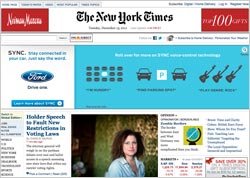Newspapers' Digital Audience Skews Younger, More Affluent
- by Erik Sass @eriksass1, December 13, 2011
 People who read newspapers’ digital content tend to be younger, better-educated and more affluent than the print audience for newspapers, according to a new national survey of
5,034 households by Pulse Research conducted from July-September of this year.
People who read newspapers’ digital content tend to be younger, better-educated and more affluent than the print audience for newspapers, according to a new national survey of
5,034 households by Pulse Research conducted from July-September of this year.
The research confirms newspapers’ success in building a substantial, and desirable, online audience.
Pulse found that the average age of digital newspaper readers is 44, compared to an average age of 51 for print readers, with disproportionate representation for young adults in digital readership.
Among adults 30 and under, there are 60% more digital readers than print readers, for a breakdown of approximately 61% digital versus 39% print in this age set. In terms of income, the average household income of digital readers was $65,480, compared to $53,776 for print readers, and the proportion of digital readers in households with incomes over $100,000 per year was 82% higher than print readers.
advertisement
advertisement
Turning to education, digital readers are 22% more likely to have a college or post-graduate degree than print readers. They are also more likely to have families, with 48% of digital readers reporting they have children at home, compared to 32% of print readers -- perhaps reflecting the fact that older print readers’ children have already left home.
Higher average household income is accompanied by greater likelihood to make big-ticket items, with 7.6% of digital newspaper readers planning to buy a home in the next year, versus 5.2% of print households. Similarly, 8.4% of digital readers plan to buy a new car in this time frame, compared to 6.8% of print readers, while 24.4% of digital readers plan to buy furniture, compared to 16.2% for print readers.


